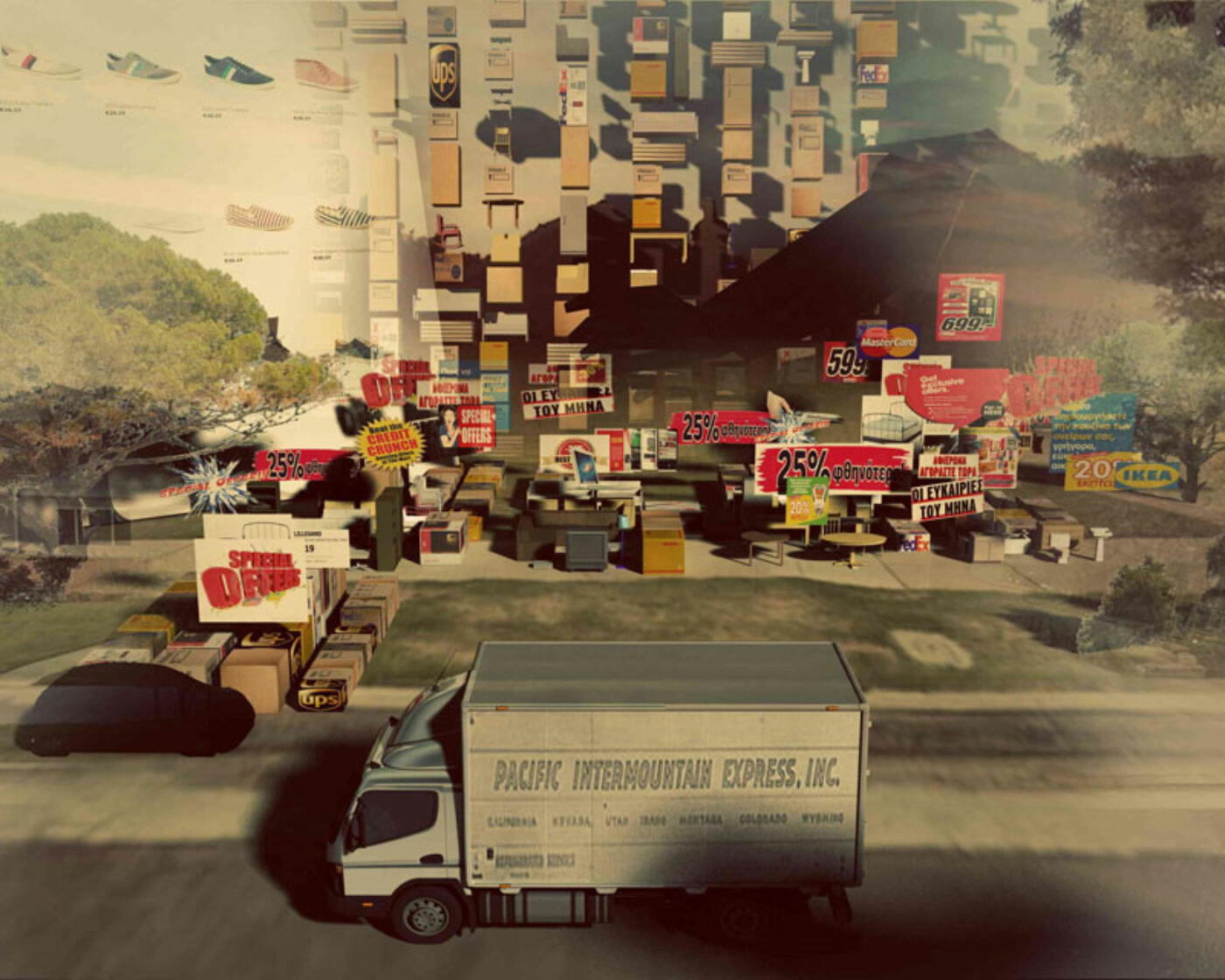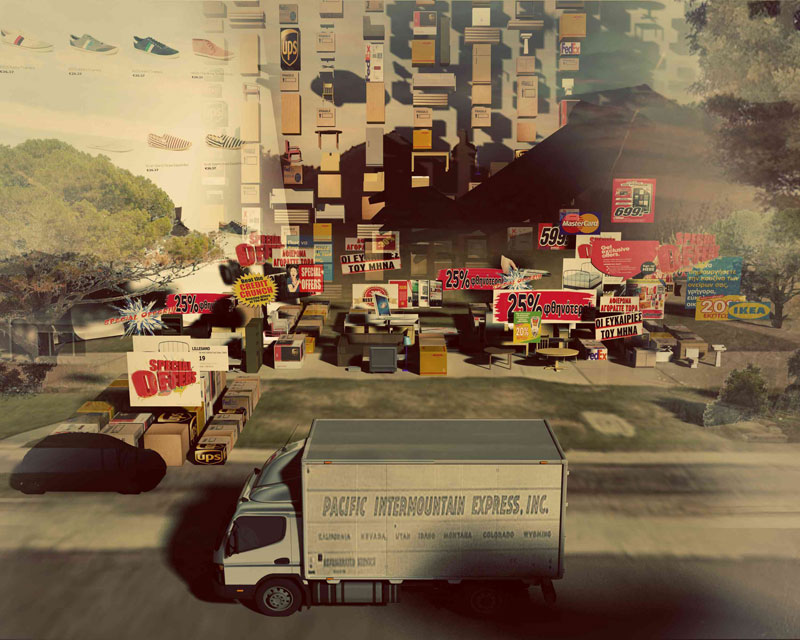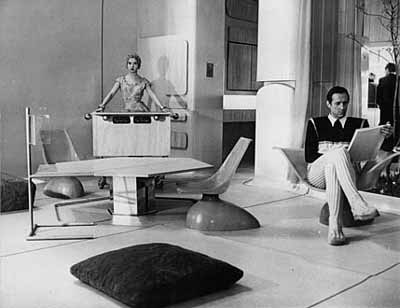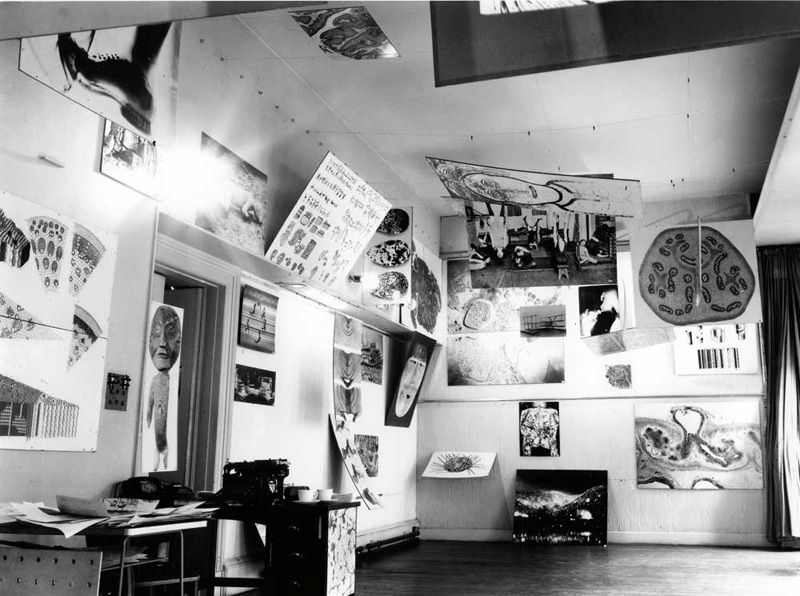
Dirk van den Heuvel sits in his home office contemplating the problem of stuff; more specifically, the rupture between the modern (architectural) urge to create a coherent interior space, and the modern (consumer) urge to accumulate and consume. From Andreas Angelidakis’ images of houses collapsing under the weight of piled up ‘things’, to the Smithsons’ efforts to reign in consumption through a form of ‘exquisite flower arrangement’, Dirk stares at has own unruly stacking of books, printers, and office supplies, adjusts his curtains, and begins his writing.
In his recent video installation ‘Domesticated Mountain’ the Greek architect Andreas Angelidakis tells a tale about the suburban house, which ends with its collapse. It talks about its inhabitants as compulsive consumers on the internet, who are ‘half asleep’, yet cannot stop browsing and scrolling the overwhelming amount of virtual images, all in order to try and fulfil their quest for ‘something to want’ by clicking and tapping the new interfaces for on-line buying. We see how the house is gradually built up from boxes delivered by one van after the other, the house grows and grows and the boxes with goodies take over the house as well as the life of the inhabitants. Resistance is futile; in this suburban world ‘civic life’ with its other values can only occur ‘as a by-product of consumption’.

The result is a blurring of the images clicked on and boxes delivered, a blurring the inhabitants can no longer control: “boxes looked like thumbnails, thumbnails looked like packages”. Because of the sheer quantity of deliveries, the goods are left unpacked, desire remains unfulfilled, and ultimately the boxes and images usurp the architecture completely. “Maybe this is the moment when we stop needing buildings” are the last words we read while we see the modernist structure collapse on the tones of a melancholic, dreamy tune. Literally, the house collapses under the weight of all those goods and packages ordered on-line. But perhaps more crucially, it collapses also metaphorically because the house offered ‘no design, just accumulation’. The lack of architecture is symptomatic: to design a house is a hopeless undertaking anyway, it is suggested, since ‘the logic of logistics’ and suburbia as the ‘city of the internet, no center, no structure’ is ‘not suited for buildings’.
In Angelidakis’ video we get glimpses of architects using the modern house as manifesto (Le Corbusier, Gehry among others), just as we see Levittown-like cityscapes with a touch of the light-hearted ridicule we know from Jacques Tati’s movies. We know these images from the avant-garde discourse just as we know them from popular culture; from the fantastic slapsticks by Buster Keaton concerning the electric house or the prefab house, to Adolf Loos’ pity for the ‘poor little rich man’ who has to suffer under the demands of the total design of his architect to Walter Benjamin’s criticism of the bourgeois house as a plush receptacle of the new consumer goods collected in such a way as to create a false sense of ownership and security.

The collapsing house and its ruin are equally familiar as images. It should be remembered at this point that the ruin is not just a symbol of collapse and cultural decline, but that it simultaneously holds its counter-image, namely that of hope, a new beginning, another dream of another future. This dialectic between collapse and hope returns in many of Andreas Angelidakis’ other projects, e.g. ‘the Cloud House’ or ‘Postcontemporary Ruin’, which hold all sorts of Utopian notions that are translated into the metaphors of landscapes of clouds and mountains: that is ex-urban places of refuge, flight and fantasy. In his 2011 animation ‘Troll, the Voluntary Ruin’, Angelidakis tells the fictional story of Chara, a housing block in Athens that falls into ruin, but then comes alive as a ruin and leaves the city to become a mountain. Despite the destruction of the house as we know it, the idea of some sort of ideal is not quite given up on.
The tension between the annihilation of the house and its possible reconfiguration is communicated throughout the presentation. On Angelidakis’ blog a statement like “the future of architecture was often expressed as a house” is crossed-out but is still readable, as if to communicate that he is still pondering this question, or that at least the visitor should ponder this question. What is most striking, is how Andreas Angelidakis once again connects the notion of images and things as key to architectural order, and how he connects the current explosion of both images and things around us to the ubiquitous systems of their production, distribution, and consumption. This is not accidental, the video and installation of the ‘Domesticated Mountain’ were made for the Gloria Maria Gallery in Milan against the backdrop of the Salone del Mobile, the ultimate stage for the exchange of domestic design and new lifestyle images.

To bring things together
That the modern suburban house is at the center of the flows of marketing, design, economics and mass production, including the ones of the servicing and financing industries, was most clearly communicated by Charles and Ray Eames, in particular through their well-known diagram ‘what is a house?’ from 1944, which neatly charted those flows. Their own house in Pacific Palisades, which was part of John Entenza’s Case Study House program, is its superb epitome. The optimistic elegance of the Eames house and its fantastic contents of disparate collections of their own modernist, high-tech furniture pieces, the found objects, the exoticist trinkets, the cheerful toys and so forth and so on, have been broadcast around the globe ever since. With the Swiss furniture company Vitra now in charge of the Eames furniture production, this broadcasting has only been further accelerated and perfected to an almost perverse level of sophistication, which no architect or designer seems to be able to resist. Arguably, hyper-self-conscious designers like Hella Jongerius, the Bouroullec brothers or Herzog & de Meuron too, are not capable of turning around the ‘logic of logistics’ that leads to the destruction of the house that Angelidakis talks about.
It was Alison and Peter Smithson who recognized both the poetic potential and the limits of what they called the Eames aesthetic. They spoke about how the Eames’ chairs were to them like a ‘message of hope from another planet’ in a post-war period of austerity and stifling English patriotic sentiment, and how the Eameses made them realize that something pretty wasn’t something socially irresponsible per se. According to the Smithsons, the basics of the Eames aesthetic was to be found exactly in the way they dealt with collections and the abundance of objects and images invading the house. To the Smithsons it boiled down to a higher form of exquisite ‘flower arrangement’, a technique of ‘select-and-juxtaposition’ or ‘select-and-arrange’, that would enhance each individual object for what it was, making it speak more clearly of itself by virtue of the arrangement. This entailed a “wide-eyed wonder of seeing the culturally disparate together and so happy with each other.”
The limits of the Eames aesthetic were associated by the Smithsons with the conditions of the very same consumer technology, to which the Eameses had brought their innovations so successfully: namely the intrusion of the house with an almost unlimited amount of ever new household appliances (remember, this is the 1950s). One or perhaps two of those appliances could still be tolerated, the Smithsons would say, as long as they were styled as ‘pop objects’ or made ‘toy-like’ (an approach perfected by Alessi today) – all following the observation how ‘leisure’ was also intruding into the house turning ‘all housework into play-housework’ under the influence of advertising and marketing. Yet, beyond a certain mass or scale the ‘select-and-arrange’ technique would simply collapse according to the Smithsons. For instance, only one ‘family-size washing-up machine’ would suffice to destroy the sophisticated delicacy of Eames styling. To avoid this collapse, the Smithsons proposed other strategies such as those of ‘concealment-and-display’ while singing the praise of ‘cupboard doors’ to visually hide the piles of superfluous objects. Hence, in their ‘Criteria for Mass Housing’ they would ask rhetorically: “Is there enough storage? There is never enough storage.”
To save the house from the gluttony of the very consumer culture to which the house belongs, a paradoxical strategy of disciplining and purist restraint is put forward in order to improve the comfort of the modern lifestyles. A whole range of idea houses is developed around the notions of ‘select-and-arrange’ and ‘concealment-and-display’. Closets, cupboards and cubicles, cells and cores, all these former bourgeois instruments return once again; they replace the glass house ideal to become major architectural devices for the smooth and invisible operating of the house and the structure of its spaces. Also the Smithson’s 1956 ‘House of the Future’ with its organically shaped interior is structured by way of such carefully planned cubicles, cupboards and other storage spaces, either to contain the new consumer goods or the human body. The idea is to maximize the ‘space available for the human drama’, to create ‘the sense of being protected in order to act’. To counter a society of cornucopia the Smithsons demanded an architecture of ‘bare spaces’, so that a “bed was a bed; the wash-stand was a wash-stand” and “everything itself and not another thing.”

It is perhaps paradoxical then, that to save the modernist dream of transparency a certain degree of repression by proper organization is a necessary requirement. However, repression doesn’t seem to be an option in the spaces of flows as depicted by Angelidakis, although the stacks of unopened boxes that make up the house and the installation suggest some form of abstinence as a first step to bypass the system and its logic.
Unstable images
With respect to this idea of bringing things and images together, this collecting, Alison and Peter Smithson said they were looking for a language of architecture that was also a ‘complete image system’. This idea of a ‘complete image system’ is perhaps best demonstrated by the ‘Parallel of Life and Art’ installation which they made together with their artist-friends Nigel Henderson and Eduardo Paolozzi. It comprised an environment of black and white reproductions from the most disparate fields (x-ray, microscopy, primitive art, sports, technology, cars, architecture, science fiction, aerial photography etc.), which were fixed on boards. They were hung freely in the gallery space of the London ICA in a seemingly random way, as to form a ‘cloud’ of images that had to trigger a game of free associations with the visitor, who were challenged to invent their own idea of order – ‘ideally from scratch’. This idea was transplanted to the domestic sphere with their second collaborative effort, the ‘Patio & Pavilion’ installation at the ‘This is Tomorrow’ show at the Whitechapel Gallery: a bare frame that was the pavilion set in an empty patio which was then ‘dressed’ with the art work of Henderson and Paolozzi once again as to set off a similar game of association and invention.

Such a ‘complete image system’ was then not only thought to be an ordering device, accommodating the unstable flow of images and objects collected, it would also produce new images, or even a new idea of order. Such image systems that are also ordering systems do not exclusively belong to the Smithsons’ oeuvre; to broaden the scope one could also think of Foucault and his Les Mots et Les Choses, translated as The Order of Things, and how Foucault opens his famous exposé on discourse with Borges’ poetic approach to the classification of collections. Other examples of ‘systems’ that bring together principles of ordering, collections of objects and images, knowledge, and architecture and its inhabitants, are Sir John Soane’s house in London, or the Domus Cosmografica of the Johan Maurits’ residence in The Hague, the current Mauritshuis.
So to what extent might we compare Angelidakis’ ‘mountain of thumbnails’ and ‘valleys of jpegs’ that we see in his installation (and on his various websites and blogs) with such ‘complete image systems’?
Besides stating that they were looking for an architecture that entailed a ‘complete image system’, Alison and Peter Smithson also insisted that the house has to be an image itself, in order to be recognized as a house. Among the already mentioned ‘Criteria for Mass Housing’ one also finds the puzzling statement: “Does the idea for the dwelling produce an absolutely clear external image?” and “Can these images add up to a composite one and is this composite socially valid, that is, is it done for some present-day human reason?”
The blurring of the image of the house with its physical reality is neither coincidental, nor an imprecision. An ‘image’ – in the Brutalist sense of the word – is understood by the Smithsons as the visual entity that connects the intellectual concept of reality with the physical world. As such it comes close to the notions of diagram or concetto. To be clear, we are not talking about postmodernist simulacra here, nor about signs as part of linguistic communication theories. Above all, there is the universalist assumption that it is only through such conceptual images that we can inhabit our houses and cities, and eventually the world; without them we would be lost. And this is perhaps the most important question that Angelidakis seems to be asking: what ‘image’ can we think of that allows us to inhabit the spaces of flows, to navigate those valleys of jpegs and to make sense out of the mountains of thumbnails?
Apparently, if we follow Angelidakis’ thoughts, there is no such image as yet, and hence the collapse of the house, that has ‘no design’ but is ‘just accumulation’. The ‘valley of jpegs’ and ‘mountain of thumbnails’ suggest a landscape, the drift through this landscape conjures up a nomadic existence; but even a nomad has a house, one of the most archetypal kind: a tent. As said, Angelidakis postpones any straightforward answer; despite the touches of hedonism and pleasure that also seem to be characteristic of his work, his is a Socratic approach. The virtual ‘dream’ houses he proposes are left unfinished, empty, open-ended; just as the boxes of the domesticated mountain are eventually left unpacked. Pre-packaged identities are untouched to rot away – instability favored as more productive and challenging the imagination.